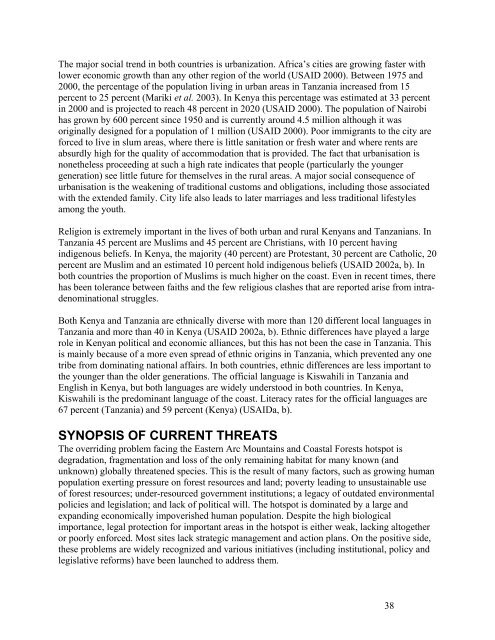Eastern Arc Mountains and Coastal Forests of Tanzania and Kenya ...
Eastern Arc Mountains and Coastal Forests of Tanzania and Kenya ...
Eastern Arc Mountains and Coastal Forests of Tanzania and Kenya ...
Create successful ePaper yourself
Turn your PDF publications into a flip-book with our unique Google optimized e-Paper software.
The major social trend in both countries is urbanization. Africa’s cities are growing faster withlower economic growth than any other region <strong>of</strong> the world (USAID 2000). Between 1975 <strong>and</strong>2000, the percentage <strong>of</strong> the population living in urban areas in <strong>Tanzania</strong> increased from 15percent to 25 percent (Mariki et al. 2003). In <strong>Kenya</strong> this percentage was estimated at 33 percentin 2000 <strong>and</strong> is projected to reach 48 percent in 2020 (USAID 2000). The population <strong>of</strong> Nairobihas grown by 600 percent since 1950 <strong>and</strong> is currently around 4.5 million although it wasoriginally designed for a population <strong>of</strong> 1 million (USAID 2000). Poor immigrants to the city areforced to live in slum areas, where there is little sanitation or fresh water <strong>and</strong> where rents areabsurdly high for the quality <strong>of</strong> accommodation that is provided. The fact that urbanisation isnonetheless proceeding at such a high rate indicates that people (particularly the youngergeneration) see little future for themselves in the rural areas. A major social consequence <strong>of</strong>urbanisation is the weakening <strong>of</strong> traditional customs <strong>and</strong> obligations, including those associatedwith the extended family. City life also leads to later marriages <strong>and</strong> less traditional lifestylesamong the youth.Religion is extremely important in the lives <strong>of</strong> both urban <strong>and</strong> rural <strong>Kenya</strong>ns <strong>and</strong> <strong>Tanzania</strong>ns. In<strong>Tanzania</strong> 45 percent are Muslims <strong>and</strong> 45 percent are Christians, with 10 percent havingindigenous beliefs. In <strong>Kenya</strong>, the majority (40 percent) are Protestant, 30 percent are Catholic, 20percent are Muslim <strong>and</strong> an estimated 10 percent hold indigenous beliefs (USAID 2002a, b). Inboth countries the proportion <strong>of</strong> Muslims is much higher on the coast. Even in recent times, therehas been tolerance between faiths <strong>and</strong> the few religious clashes that are reported arise from intradenominationalstruggles.Both <strong>Kenya</strong> <strong>and</strong> <strong>Tanzania</strong> are ethnically diverse with more than 120 different local languages in<strong>Tanzania</strong> <strong>and</strong> more than 40 in <strong>Kenya</strong> (USAID 2002a, b). Ethnic differences have played a largerole in <strong>Kenya</strong>n political <strong>and</strong> economic alliances, but this has not been the case in <strong>Tanzania</strong>. Thisis mainly because <strong>of</strong> a more even spread <strong>of</strong> ethnic origins in <strong>Tanzania</strong>, which prevented any onetribe from dominating national affairs. In both countries, ethnic differences are less important tothe younger than the older generations. The <strong>of</strong>ficial language is Kiswahili in <strong>Tanzania</strong> <strong>and</strong>English in <strong>Kenya</strong>, but both languages are widely understood in both countries. In <strong>Kenya</strong>,Kiswahili is the predominant language <strong>of</strong> the coast. Literacy rates for the <strong>of</strong>ficial languages are67 percent (<strong>Tanzania</strong>) <strong>and</strong> 59 percent (<strong>Kenya</strong>) (USAIDa, b).SYNOPSIS OF CURRENT THREATSThe overriding problem facing the <strong>Eastern</strong> <strong>Arc</strong> <strong>Mountains</strong> <strong>and</strong> <strong>Coastal</strong> <strong>Forests</strong> hotspot isdegradation, fragmentation <strong>and</strong> loss <strong>of</strong> the only remaining habitat for many known (<strong>and</strong>unknown) globally threatened species. This is the result <strong>of</strong> many factors, such as growing humanpopulation exerting pressure on forest resources <strong>and</strong> l<strong>and</strong>; poverty leading to unsustainable use<strong>of</strong> forest resources; under-resourced government institutions; a legacy <strong>of</strong> outdated environmentalpolicies <strong>and</strong> legislation; <strong>and</strong> lack <strong>of</strong> political will. The hotspot is dominated by a large <strong>and</strong>exp<strong>and</strong>ing economically impoverished human population. Despite the high biologicalimportance, legal protection for important areas in the hotspot is either weak, lacking altogetheror poorly enforced. Most sites lack strategic management <strong>and</strong> action plans. On the positive side,these problems are widely recognized <strong>and</strong> various initiatives (including institutional, policy <strong>and</strong>legislative reforms) have been launched to address them.38
















